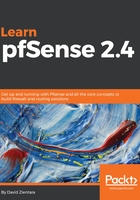
上QQ阅读APP看书,第一时间看更新
The seven-layer OSI model
At this point, we will introduce a conceptual model that will hopefully clarify a number of basic networking concepts—the Open Systems Interconnect (OSI) reference model. This model was created by the International Organization for Standards (ISO) in 1978, and was revised in 1984. It divides networking into seven layers, as follows:
- Physical: This is simply the network's physical characteristics, including the hardware and network topology.
- Data link layer: This layer is responsible for getting data to the physical layer, as well as error detection, error correction, and hardware addressing. It also has two sublayers:
- Media Access Control (MAC): The MAC address, the 48 or 64-bit hardware address that's burned into the network card. It is defined at this sublayer, which also controls access to the device.
- Data link: This sublayer is responsible for the error correction and flow-control capabilities of the layer.
- Network: The primary responsibility for this layer is to handle routing—that is, providing a means for network data to pass from one network to another. This functionality is provided via network protocols.
- Transport: This layer provides connection services between devices and ensures the reliable delivery of data via error checking, service addressing (making sure that data is passed to the right service), and segmentation (dividing data into packets). This layer also provides flow control by adding buffering and windowing (the size of a window determines how many packets can be sent before receiving an acknowledgment).
- Session: This layer is responsible for controlling the synchronization of data between applications on different nodes, which it does by establishing, maintaining, and breaking sessions.
- Presentation: This layer translates data from a format used by applications to one in which it can be transported across the network. This layer provides encryption, compression, and decompression functionality.
- Application: This layer takes data from the users and passes it on to lower layers of the OSI model.
If the full import of this model is not apparent yet, you needn't worry: different aspects of it will be revisited throughout this text. This section deals primarily with the first four layers of the OSI model, as they are the most relevant to your understanding of basic networking.